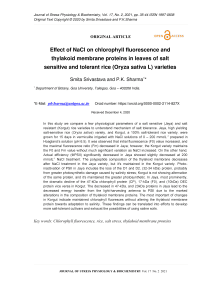Effect of NaCl on chlorophyll fluorescence and thylakoid membrane proteins in leaves of salt sensitive and tolerant rice (Oryza sativa L) varieties
Автор: Smita Srivastava, P.K. Sharma
Журнал: Журнал стресс-физиологии и биохимии @jspb
Статья в выпуске: 2 т.17, 2021 года.
Бесплатный доступ
In this study we compare a few physiological parameters of a salt sensitive (Jaya) and salt resistant (Korgut) rice varieties to understand mechanism of salt tolerance. Jaya, high yielding salt-sensitive rice (Oryza sativa) variety, and Korgut, a 100% salt-tolerant rice variety, were grown for 15 days in vermiculite irrigated with NaCl solutions of 0 – 200 mmolL-1 prepared in Hoagland’s solution (pH 6.5). It was observed that initial fluorescence (F0) value increased, and the maximal fluorescence ratio (Fm) decreased in Jaya; however, the Korgut variety maintains the F0 and Fm value without much significant variation as NaCl increased. On the other hand, Actual efficiency (ΦPSII) significantly decreased in Jaya showed slightly decreased at 200 mmolL-1 NaCl treatment. The polypeptide composition of the thylakoid membrane decreases after NaCl treatment in the Jaya variety, but it's maintained in the Korgut variety. Photo-inactivation of PSII in Jaya includes the loss of the D1 and D2, (32-34 kDa) protein, probably from greater photosynthetic damage caused by salinity stress; Korgut is not showing alternation of the same protein, and it's maintained the greater photosynthetic. In Jaya, most prominently, the dramatic decline of the 47-kDa chlorophyll protein (CP), 17-kDa (F0), and (10kDa) OEC protein vice versa in Korgut. The decreased in 47-kDa, and 23kDa proteins in Jaya lead to the decreased energy transfer from the light-harvesting antenna to PSII due to the marked alterations in the composition of thylakoid membrane proteins. The most important of changes in Korgut indicate maintained chlorophyll fluoresces without altering the thylakoid membrane protein towards adaptation to salinity. These findings can be translated into efforts to develop more salt-tolerant cultivars and exhaust the possibilities of using saline soils.
Chlorophyll fluorescence, rice, salt stress, thylakoid membrane proteins
Короткий адрес: https://sciup.org/143173887
IDR: 143173887
Текст научной статьи Effect of NaCl on chlorophyll fluorescence and thylakoid membrane proteins in leaves of salt sensitive and tolerant rice (Oryza sativa L) varieties
Salt stress is significant abiotic stress that limits plant growth and productivity worldwide (Misra et al., 1997 and Vinocur et al., 2005, Garg et al., 201 and Jiang et al., 2012). The higher level of salt concentrations results in primary salt stress, composed of osmotic stress and ion toxicity, and secondary oxidative stress (Wang et al. 200 ) and also causes severe damage to plants, including growth inhibition, impaired metabolism, necrosis, and loss of production and quality (Sivritepe et al., 1999). F 0 increased as the NaCl concentration increase (Flood et al. 2001; Yamane et al. 2008; Sarkar et al. 201 ). The thylakoid membrane was damaged at the highest salinity level (Yamane et al. 2004). The increased F 0 values were due to the disassociation of light-harvesting complex II (LHC II) and the PSII reaction center on swollen thylakoids (Yamane et al. 2008); however, F m (maximum fluorescence yield in the absence of photosynthetic light) was also decreased in plants under salinity stress compared with control (Yamane et al., 2008, Lutts et al. 1996). ΦPSII, which participates in absorbed energy used in photochemistry and determines the efficiency of PSII. It is affected the concentrations of electron acceptors, e.g., NADP+, available at the acceptor side of PSI. The value of ΦPSII more declined insensitive variety than tolerant under salt stress (Dionisio et al. 2000 . However, another study (Moradi et al. 2007) had the opposite result; the effect of salinity does not show any changes in ΦPSII. However, the electron transport rate (ETR) shows a reduction during salinity. Another study showed a direct correlation between decreased F v /F m and decreased ΦPSII due to salinity (Yamane et al. 2008).
The surface of thylakoid membranes plays a vital role in the evolution of oxygen (Miao and Murata 198 , 1984; Murata et al., 1992). Chloroplast membranes contain the multiprotein photosynthetic complexes photosystems I and II, including the reaction centers responsible for converting light energy into chemical bond energy and a cytochrome b6/f complex and an ATPase. Light reaction of photosynthesis occurs in the thylakoid membranes of the Chloroplast. These reactions take place by involving the coordination between the 100 proteins that are organized in four major multisubunit protein complexes: the PSI, PSII, cytochrome b6/f (cyt b6/f) complex, and the ATP synthase complex (Hippler et al., 2001). Proteins that form the PSII core complex in land plants include PSII reaction center core proteins D1 and D2 (i.e., PsbA and PsbD; Psb stands for PSII), core antenna proteins CP4 and CP47 (i.e., PSII chlorophyll proteins of 4 and 47 kDa, also known as PsbC and PsbB, respectively (Nickelsen et al. 201 . PSI core complex binds to the membrane-bound peripheral antenna, called LHCI, and this antenna consists of four polypeptides called Lhca1 (22 kDa), Lhca2 (2 kDa), Lhca (25 kDa), and Lhca4 (22 kDa) (Jansson, 1994). ATPase synthase complex of Chloroplast is also known as the F1 F0-ATP synthase. It consists of 24 kDa cytochrome b6 subunit, 17 kDa subunit IV, 19 kDa Rieske iron-sulfur protein, and 1 kDa c-type cytochrome f subunit. The RC of PSII comprises of D1 protein ( 2 kDa) and D2 protein ( 4 kDa), two large subunits CP47 (47 kDa) and CP4 (4 kDa), two small subunits forming Cyt b559 (9 and 5 kDa), that resulted in inactivation of both PS II and PS 1 mediated electron transport and damage of the oxygenevolving machinery of PS II (Allakhverdiev et al., 2000a,b). A decrease in the maximum quantum efficiency of PS II, a variable to maximum fluorescence ratio, and the photochemical quantum yield of PS II were reported in Cucumis sativus leaves under salt stress (Stępień and Kłobus 2006).
The expressed proteins are having a molecular weight ranging from 45-190 kDa. The bands of low molecular weight proteins such as 45, 48, 7 , and 97 kDa have shown higher intensities under salinity treatment. Several authors have reported that low molecular weight proteins ranging from 22-127 kDa accumulate in the plants like Raphanus sativus (Lopez et al., 1994), Arachis hypogea (Hassanein et al., 1999), and Maize (Tamas et al., 2004) under saline conditions. It has been reported that salinity causes a decrease in the intensity of several proteins in Bruguiera parviflora (Parida et al., 2004). Some investigations have shown that the high salt concentration inhibits the activity of
PSII (Akram and Ashraf 2011), while others demonstrated that PSII activity remains unchanged (Lu et al., 2002, 200 ). Differences have also been shown in the polypeptide composition of PSII in salt-tolerant and salt-sensitive plant species (Wang et al., 2009).
Photosynthetic efficiency is a crucial factor in determining plant resistance to abiotic stresses. When an optimum amount of salt enters the plant cell, the membrane system and function of thylakoids in chloroplasts could be destroyed, affecting the photosynthetic activity if the salt concentration is not regulated to optimum values. The present report, undertaken to understand the salinity induced changes in chlorophyll fluorescence and the thylakoid membrane protein in salt-sensitive and salt-tolerant cultivars of rice.
MATERIALS AND METHODS
Plant material
Rice seeds of salt-sensitive (Jaya) and salt-tolerant (Korgut) cultivars obtained from the agricultural department of Ponda GOA were grown on Vermiculite medium in plastic pots.
Salinity treatment
Plastic pots of medium size (having a diameter of 12 cm) filled with vermiculite were irrigated with different respective concentrations of NaCl (0mM -200 mmol l-1 solution prepared in distilled water, and pots were wetted with an individual concentration of NaCl before sowing the seeds. Approximately 100 seeds were buried in each pot by first wetting the vermiculite with 100 ml of NaCl respective concentration and covering it with a small amount of vermiculite. Pots with the different concentrations were kept in separate trays. The solutions were poured from the top, and excess solutions were discharged from the pot's base's pores. Pots were watered every alternate day. Plantlets were grown for four weeks in a plant growth room illuminated with fluorescent and incandescent lamps with 16 hours photoperiod of ~500 μmol m-2 s-1 PAR, and the temperature was set to 26°C ± °C; experiments were repeated five times with three replicates.
Chlorophyll fluorescence parameters,
Minimal fluorescence (Fo), maximal fluorescence (Fm), and the ΦPSII=(F′m-Ft)/F′m measured to be used to fully expanded four leaves. Measurements were carried out using a fluorescence monitoring system (PAM instruments), according to Sharma et al . (1997).
Isolation of Chloroplast
The isolate of Chloroplast followed the method of Sharma and Singhal (1992). Fresh leaves (4g) were chopped into small pieces and homogenized in grinding media (GM) containing Sorbital, tricine, MgCl 2 , NaCl, EDTA (pH 7.2). The homogenate was filtered through four layers of muslin cloth. The filtrate was centrifuged at 8000 rpm for 10 min. Pellet was washed twice with resuspending media (RM) containing (Sorbitol, tricine, MgCl2, MnCl2, NaCl, EDTA (pH 7.8) and then resuspended in the same media. All steps were performed at 4°C.
Determination of protein concentration for loading in SDS-PAGE:
Chloroplast suspension was stored at -80°C for 24 h followed by lyophilizing the chloroplast pellet for 5h; lyophilized samples dissolved in reaction media and used to quantitate the protein concentration using the Bradford method (1976).
Preparation of protein sample for SDS-PAGE:
After protein quantification, resuspended Chloroplast was mixed in 2 X SDS proteins solubilizing buffer (lammeli) for 0 min in ice and stored overnight to complete solubilization of protein samples 4°C. The solubilized sample was heated at 90°C for min followed by the incubated on ice immediately for 1min, then centrifuging the samples at 12000 rpm for 1min. The supernatant was used as a chloroplast protein.
SDS- PAGE:
For SDS-PAGE, 12µg equivalent of protein was electrophoresed on 5% stacking and 15% resolving polyacrylamide gels (Table. 1) at 50v for 0 min and 120V for 2h with a PROTEAN II XI 2-D cell (BIO-RAD). Molecular weights of different protein bands were determined with the help of standard protein markers
(Himedia, pre-stained 245-11 kDa). Gels were subsequently washed with water and placed in microwave oven till 2 min and then poured water out after that put stained with staining solution containing 0.1% Coomassie brilliant blue R -250 (SIGMA), 10% Glacial acetic acid (GAA) and 50% methanol for 1 hour followed by distaining the excess of stain using destainer 1 containing 10% GAA and 5% methanol and finally gel was placed in a distilled water. Gels were scanned using Bio-Rad Gel Densitometer (GS 800) and analyzed using Quantity One software from Bio-Rad.
Table. 1. Composition of SDS-PAGE
|
Composition |
10ml of Resolving gel (15%) |
5 ml of stacking gel (5%) |
|
Double distilled water |
.2 ml |
2.97ml |
|
Acrylamide /bisacrylamide ( 0%) |
4ml |
0.67ml |
|
1.5 M Tris (PH 8.8) |
2.6ml |
- |
|
0.5 M Tris-HCl (PH 6.8) |
- |
1.25ml |
|
10% (w/v) SDS |
0.1 ml |
0.05ml |
|
10% (W/V) APS |
0.1ml |
0.05ml |
|
TEMED |
0.p1ml |
0.005ml |
RESULTS
Fluorescence measurements
Initial chlorophyll fluorescence (F 0 ) was highest in Jaya as it showed an increase of 40 %, whereas, in Korgut, it showed lowest (15%) at 200 mmol l-1 NaCl as compared to their control. F m value in Jaya also decreased by 6 % at 200 mmol l-1 NaCl, while in Korgut, it showed only a 21 % reduction as compared to their control. Whereas ϕPSI change up to 40 mmol l-1 NaCl treatments but decreased by 2 % at 120 and 42 % at 200 mmol l-1 NaCl concentrations in Jaya variety. On the other hand, Korgut showed a slight decrease of 6% at the highest concentration (200 mmol l-1) NaCl (Fig.1).
Chloroplast protein
For SDS – PAGE, proteins were extracted from leaf tissue of salt-tolerant and sensitive rice plants.
Comparing the protein profiles between the control plant and those treated with different salt concentrations using SDS- PAGE showed that NaCl treatment induced significant protein pattern changes. In our study, a total of 8 distinct bands corresponding to polypeptide from thylakoid membranes were observed (Fig. 2,2a; , a). The identified polypeptides observed in Jaya control and NaCl treated plants showed qualitative changes and were 75-6 kDa chloroplast coupling factor (CF1) protein level remained at the same level in all the NaCl treated plants as seen in control (Fig. 2 & 2a). Whereas, CP47 and CP4 kDa protein showed a slight decrease with increasing NaCl concentration (Fig. 2a A-G). A similar pattern was also observed for 2- 5 kDa protein D1 and D2; it showed a slight decrease in the protein amount at the highest NaCl concentration (200 mmol l-1). However, LHC (25-20kDa) protein linearly decreased as NaCl concentration increased compared to their control (Fig 4). Whereas 17kDa (F O binding site of CF1) showed a linear increase with the increased NaCl concentration up to 80 mmol l-1 NaCl compared to control; however, the highest concentration showed decreased compared to control (Fig 2, 2a A-G, Fig.5b). OEC (10-11kDa) protein remained more or less at the same level as seen in control up to 80mmol l-1 NaCl compared to control, however, the highest concentration has an absence of identical in Jaya variety (fig.2a, Fig 5a). However, the Korgut variety Chloroplast coupling factor (CF1) protein level linearly increased as NaCl concentration increases (Fig. . ) 54). Simultaneously, CP47 and CP4 kDa protein showed a slight increase in NaCl concentration (Fig. , a A-G). A similar pattern was also observed for 2- 5 kDa protein D1 and D2. LHC (25-20kDa) protein showed a linear decrease with increasing NaCl concentration in Jaya while raised in the Korgut than their control (Fig. . a, A-G). However in Korgut variety, 17kDa (FO binding site) poypeptide increased linearly with increasing NaCl concentration; a similar pattern was also observed for OEC (10-11kDa) protein compared to their control (Fig. 5a,b).

Fig. 1. Effect of NaCl on chlorophyll fluorescence parameters in both rice varieties. The data in (a), (b), and (c) represent Fo. Fm and qPSII respectively. Results are expressed as mean ± SD of three replicates. (*), (*•), (***) indicates that the mean difference between salt stress response compared to control is significant p<0.5, p<0.01, andp<0.005, respectively.
(Chloroplast coupling Fl)
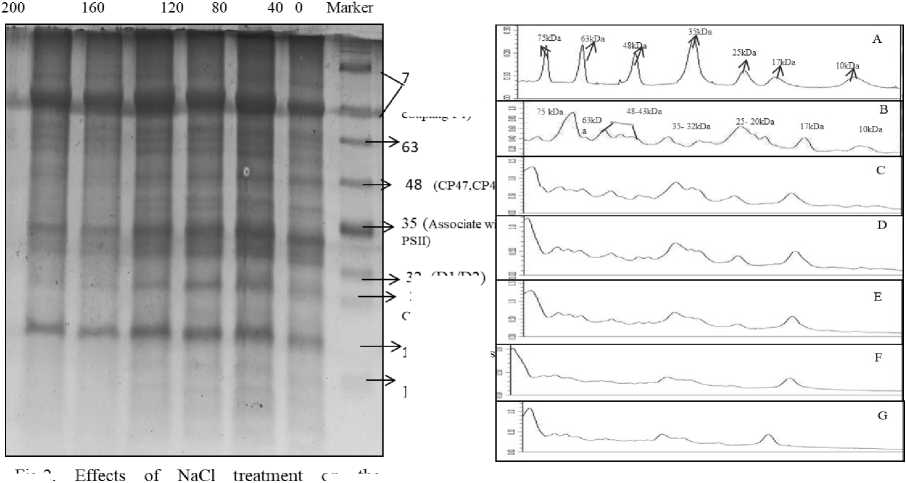
32 (D1/D2)
Complex)
17 (FO binding s
(OEC)
Fig.2.
on the
polypeptide composition of thylakoid membranes of Jaya variety. The molecular weights of the markers are given in kDa. Results shown are representative of three independent trials.
Fig.2a. Optical density profile of thylakoid membrane polypeptides from leaves of Jaya plants treated with different concentration of NaCl. Marker (A), Control (B), 40 mmol H (C), 80 mmol I1 CD), 120mmol 11 (E), 160 mmol 11 (F) and 200 mmol INaCJ (G).
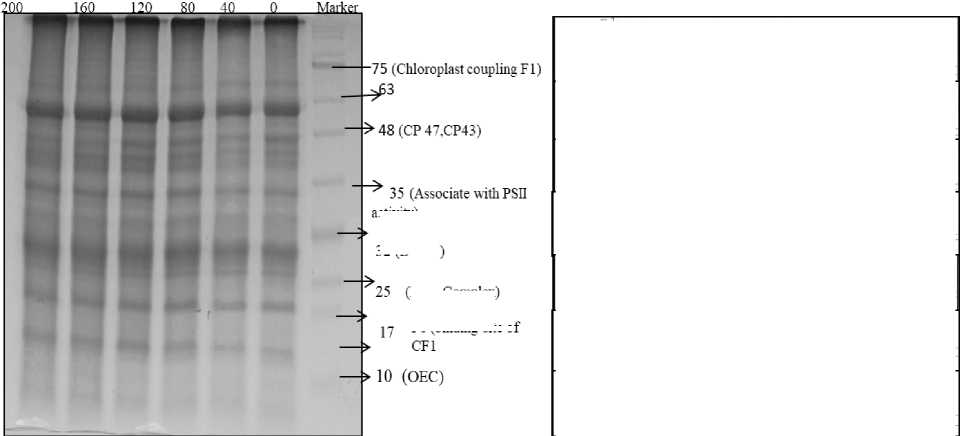
Fig.3. Effects of NaCl treatment on the polypeptide composition of thylakoid membranes of Korgut variety. The molecular weights of the markers are given in kDa. Results shown are representative of three independent trials.
activity)
32 (D1/D2)
(LHC Complex)
FO (biudine site of
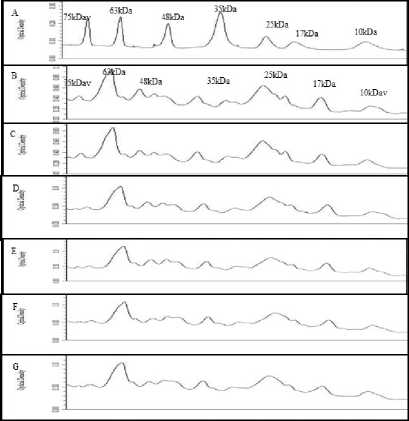
Fig. 3a. Optical density (O. D.) profile of thylakoid membrane polypeptides from leaves of Korgut plants treated with different concentration of NaCl. Marker (A), Control (B), 40 mmol I"1 (C), 80 mmol I"1 (D), 120 mmol f1 (E), 160 mmol 11 (F) and 200 mmol I1 NaCl (G).
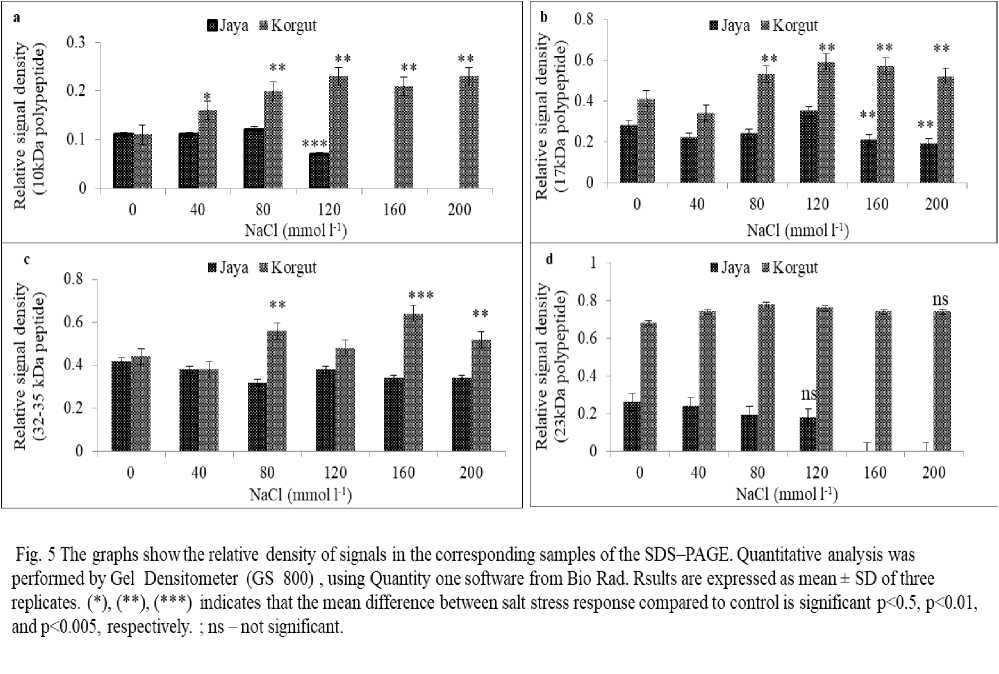
DISCUSSION
The F0, Fm, Fv/Fm, qP, and qNP values are the most crucial chlorophyll fluorescence parameters broadly used in plant stress physiology studies (Thomas and Turner 2001; Baker and Rosenquiest 2004; Murchie and
Lawsons, 201 ). An increase in F0 represents only difficulty and degradation in photosystem II (D1 protein and other parts of Photosystems) or any disruption in energy transfer into the reaction center (Calatayud et al., 2006). It has been reported that F0 would increase under full stress conditions, but the Fv/Fm ratio would be reduced (Maxwell and Johanson 2000 and Li et al., 2010). In the present study, the F0 value significantly increased in the Jaya variety, whereas Korgut showed an insignificant increase as NaCl increase. Besides, the increase in F0 can also be a negative trait associated with stress, resulting in the deactivate of the PSII reaction center (Yamane et al. 1995; 1997). However, the significantly decreased the Fm value in Jaya than in Korgut. The higher decrease in Fm in Jaya may be due to inhibition of electron transport at the PS-II donor site, which results in the accumulation of P680, and the other reason may be the decrease in the pool size of QA. The shallow Fm values determined in Jaya plants grown under salt stress indicate the accumulation of inactive PS-II reaction centers (also considered higher F0). The value of ΦPSII declined in the salt-sensitive Jaya variety under salt stress, whereas the tolerant variety exhibited higher values than their control (Fig. 1c). Decreased ΦPSII, which is also the decreased PSII quantum yield, represents the segments of absorbed energy used in photochemistry, which determines the reductant efficiency, which caused the slow rate of electron transport, available at the acceptor side of PSI. Similar results are reported by Takai et al. (2010) in rice. However, another study (Wang et al. 2015) had the opposite impact; that exposure of salinity did not change plant resistance to abiotic stresses. Due to the high salinity membrane system and function of thylakoids in chloroplasts could be destroyed, affecting the photosynthetic activity; if the salt concentration is not regulated to optimum values, the electron transport rate (ETR) declined. Another study also indicated that ΦPSII decreased severely when Fv/Fm decreased slightly under different levels of salinity stress (Van et al. 2019). The salt-stressed Jaya's pigment-protein complexes showed a gradual decrease in the polypeptide contents, increasing the NaCl concentration. However, salt-tolerant Korgut showed increased with an increase in salinity levels (Fig. , a). A decrease in the polypeptide contents in SDS-PAGE of Jaya suggests salinity-induced proteolysis of thylakoid membrane proteins (Misra et al. 1995, 1997b).
The relative effect of NaCl stress on Jaya is more prominent than that of Korgut, which could be due to genetic variations between these two crop plants to salinity. Our study suggests the negative effect of excess NaCl on the light reaction in Korgut.
The observed decrease in abundance of LHC (25-28 kDa) protein in Jaya may suggest the effect of NaCl on decreasing their efficiency for capturing light energy and transferring it to RC, and this can be related to the observed decrease in F0 corresponding to the disorganization of LHC in our study (Fig. .2. A-G). The observed decrease in the abundance of D1/D2 ( 2- 4 kDa) protein corresponding to the RC of PSII can be related to decrease in ΦPSI suggest that NaCl may have affected the number of functional reaction centers, which can be related to the observed decrease in the Fm corresponding to the open reaction centers. The coupling factor (6 -65 kDa) showed a slight increase in Korgut as NaCl increases suggesting that excess NaCl may not have affected these proteins, whereas, in Jaya, it decreased as NaCl increased. These results are by Tiwari et al. (1997) and Murata et al. (2007). Singh and Dubey (1995) found no PS1 activity decline in rice seedlings while PSII activity decreased significantly. The fluorescence emission spectrum, such as Fm and ΦPSI, was reduced in Jaya under NaCl stress. This data confirms that salt stress changes thylakoids' construction, destroying the PSII reaction center and combination state of Chl molecules in light-harvesting two complexes (LHC2) (Liu and Shen 2004, 2005). The isolated thylakoid membranes contained CP47, CP4 , and 2 kDa proteins (Fig. 1). Contents of these thylakoid proteins decreased in Jaya while increased in Korgut as concentration NaCl increases, which are the key to oxygen evolution (Murata et al. 1992). The decrease of 2 kDa protein in Jaya or effect of energy transformation in light-harvesting complex 1 (LHC1) results from the decrease in photochemical activity similar result also observed by (Oquist et al. 1980). Therefore, we did not find a decrease of 2 kDa peptides in the salt-tolerant Korgut variety. The reduction of 10 kDa protein in Jaya while in Korgut increased significantly under the stress conditions.
In contrast to the control, it might be due to repair of PS II damage and the maintenance of water photooxidation rate during photosynthesis. Higher expression levels of this protein in the salt-tolerant genotype than the salt-sensitive one depicted the former genotype's stabilizing capacity during salt stress conditions. A similar increase in this protein level has been observed under drought (Ghabooli et al., 201 ). Chilling (Ashley et al., 2014) and salt stress (Wu et al., 2014).
In summary, the Korgut could stably maintain thylakoid membrane polypeptides at high levels while expressing some thylakoid protein increase, which helps repair the damage in PS II and the water photo-oxidation maintenance rate photosynthesis and improved, ΦPSII, Fm and F 0 of PSII photochemistry. Thus, the results in this study suggest that Korgut has better adaptation to withstand higher salinity. This evidence indicates that salt stress is essential for breeding and improving tolerant cultivars to increase plant productivity.
ACKNOWLEDGMENTS
We are grateful to Goa University for his support and encouragement.
CONFLICTS OF INTEREST
All authors have declared that they do not have any conflict of interest for publishing this research.
Список литературы Effect of NaCl on chlorophyll fluorescence and thylakoid membrane proteins in leaves of salt sensitive and tolerant rice (Oryza sativa L) varieties
- Ball, M. C., Mehlhorn, R. J., Terry, N., & Packer, L. (1985). Electronic spin resonance studies of ionic permeability properties of thylakoid membranes of Beta vulgaris and Avicennia germinans. Plant Physiology, 78(1), 1–3. doi:10.1104/pp.78.1.1
- Berthold, D. A., Babcock, G. T., & Yocum, C. F. (1981). A highly resolved, oxygen-evolving photosystem 2 preparation from spinach thylakoid membranes: EPR and electron-transport properties. FEBS Letters, 134(2), 231–234. doi:10.1016/0014-5793(81)80608-4
- Bossmann, B., Knoetzel, J., & Jansson, S. (1997). Screening of chlorina mutants of barley (Hordeum vulgare L.) with antibodies against light-harvesting proteins of PS I and PS II: absence of specific antenna proteins. Photosynthesis Research, 52(2), 127-136.
- Calatayud, A., Pomares, F., & Barreno, E. (2006). Interactions between nitrogen fertilization and ozone in watermelon cultivar Reina de Corazones in open-top chambers. Effects on chlorophyll a fluorescence, lipid peroxidation, and yield. Photosynthetica, 44(1), 93-101.
- Coombs, J., Hall, D. O., & Long, S. P. (1985). Techniques in bioproductivity and photosynthesis (pp. 136–137).
- Diao, F. Q., Zhang, W. H., & Liu, Y. L. (1997). Changes in composition and function of thylakoid membrane isolated from barley seedling leaves under salt stress. Acta Phytophysiol., 23, 105–110.
- Dionisio-Sese, M. L., & Tobita, S. (2000). Effects of salinity on sodium content and photosynthetic responses of rice seedlings differing in salt tolerance. Journal of Plant Physiology, 157(1), 54–58. doi:10.1016/S0176-1617(00)80135-2
- Flood, P. J., Harbinson, J., & Aarts, M. G. M. (2011). Natural genetic variation in plant photosynthesis. Trends in Plant Science, 16(6), 327–335. doi:10.1016/j.tplants.2011.02.005
- Garg, B., Puranik, S., Misra, S., Tripathi, B. N., & Prasad, M. (2013). Transcript profiling identifies novel transcripts with unknown functions as primary response components to osmotic stress in wheat (Triticum aestivum L.). Plant Cell, Tissue and Organ Culture, 113(1), 91–101. doi:10.1007/s11240-012-0254-2
- Ghabooli, M., Khatabi, B., Ahmadi, F. S., Sepehri, M., Mirzaei, M., Amirkhani, A., . . . Salekdeh, G. H. (2013). Proteomics study reveals the molecular mechanisms underlying water stress tolerance induced by Piriformospora indica in barley. J. Proteome, 4, 289–301
- Hassanein, A. M. (1999). Alterations in protein and esterase patterns of peanut in response to salinity stress. Biologia Plantarum, 42(2), 241–248. doi:10.1023/A:1002112702771
- Heinz, S., Liauw, P., Nickelsen, J., & Nowaczyk, M. (2016). Analysis of photosystem II biogenesis in cyanobacteria. Biochimica Et Biophysica Acta (BBA)-Bioenergetics, 1857(3), 274-287.
- Hippler, M., Klein, J., Fink, A., Allinger, T., & Hoerth, P. (2001). Towards functional proteomics of membrane protein complexes: Analysis of thylakoid membranes from Chlamydomonas reinhardtii. Plant Journal, 28(5), 595–606. doi:10.1046/j.1365-313X.2001.01175.x
- In, Y. Y. (1995). Photosynthesis: From light to biosphere Effects of high temperatures on photosynthetic systems in higher plants. 1. In P. Mathis (Ed.), Causes of the increase in the fluorescence Fo level (pp. 849–852). Dordrecht: Springer.
- Jiang, F., Chen, L., Belimov, A. A., Shaposhnikov, A. I., Gong, F., Meng, X. (2012). Multiple impacts of the plant growth-promoting rhizobacterium Variovorax paradoxus 5C-2 on nutrient and ABA relations of Pisum sativum. Journal of Experimental Botany, 63(18), 6421–6430. doi:10.1093/jxb/ers301
- Lopez, F., Vansuyt, G., Fourcroy, P., & Casse-Delbart, F. (1994). Accumulation of a 22-kDa protein in the leaves of Raphanus sativus in response to salt stress or water deficit. Physiologia Plantarum, 91, 605–614
- Lu, C., Qiu, N., Lu, Q., Wang, B., & Kuang, T. (2002). Does salt stress lead to increased susceptibility of photosystem II to photo inhibition and changes in photosynthetic pigment composition in halophyte Suaeda salsa grown outdoors. Plant Science, 163(5), 1063–1068. doi:10.1016/S0168-9452(02)00281-9
- Lu, C., Qiu, N., Wang, B., & Zhang, J. (2003). Salinity treatment shows no effects on photosystem II photochemistry, but increases the resistance of photosystem II to heat stress in halophyte Suaeda salsa. Journal of Experimental Botany, 54(383), 851–860. doi:10.1093/jxb/erg080
- Lutts, S., Kinet, J. M., & Bouharmont, J. (1996). NaClinduced senescence in leaves of rice (Oryza sativa L.) cultivars differing in salinity resistance. Annals of Botany, 78(3), 389–398. doi:10.1006/anbo.1996.0134
- Misra, A. N., Sahu, S. M., Misra, M., Singh, P., Meera, I., Das, N., . . . Sahu, P. (1997). Sodium chloride induced changes in leaf growth, and pigment and protein contents in two rice cultivars. Biologia Plantarum, 39(2), 257–262. doi:10.1023/A:1000357323205
- Moradi, F., & Ismail, A. M. (2007). Responses of photosynthesis, chlorophyll fluorescence and ROSscavenging systems to salt stress during seedling and reproductive stages in rice. Annals of Botany, 99(6), 1161–1173. doi:10.1093/aob/mcm052
- Murchie, E. H., & Lawson, T. (2013). Chlorophyll fluorescence analysis: a guide to good practice and understanding some new applications. Journal of experimental botany, 64(13), 3983-3998.
- Nishida, I., & Murata, N. (1996). Chilling sensitivity in plants and cyanobacteria: the crucial contribution of membrane lipids. Annual review of plant biology, 47(1), 541-568.
- Parida, A. K., Das, A. B., & Mohanty, P. (2004). Investigations on the antioxidative defense responses to NaCl stress in a mangrove, Bruguiera parviflora: Differential regulations of isoforms of some antioxidative enzymes. Plant Growth Regulation, 42(3), 213–226. doi:10.1023/B:GROW.0000026508.63288.39
- Roháček, K., Soukupová, J., & Barták, M. (2008). Chlorophyll fluorescence: a wonderful tool to study plant physiology and plant stress. Plant Cell Compartments-Selected Topics. Research Signpost, Kerala, India, 41-104.
- Sarkar, R. K., Mahata, K. R., & Singh, D. P. (2013). Differential responses of antioxidant system and photosynthetic characteristics in four rice cultivars differing in sensitivity to sodium chloride stress. Acta Physiologiae Plantarum, 35(10), 2915–2926. doi:10.1007/s11738-013-1322-x
- Shahbaz, M., Ashraf, M., Akram, N. A., Hanif, A., Hameed, S., Joham, S., & Rehman, R. (2011). Salt-induced modulation in growth, photosynthetic capacity, proline content and ion accumulation in sunflower (Helianthus annuus L.). Acta Physiologiae Plantarum, 33(4), 1113-1122.
- Sharma, P. K., & Singhal, G. S. (1992). Influence of photoinhibition on photosynthesis and lipid peroxidation. Journal of Photochemistry and Photobiology B: Biology, 13(1), 83-94.
- Singh, A. K., & Dubey, R. S. (1995). Changes in chlorophyll a and b contents and activities of photosystems 1 and 2 in rice seedlings induced by NaCl. Photosynthetica, 31, 489–499.
- Sivritepe, N., & Eris, A. (1999). Determination of salt tolerance in some grapevine cultivars (Vitis vinifera L.) under in vitro conditions. Turkish Journal of Biology, 23, 473–485.
- Spence, A. K., Boddu, J., Wang, D., James, B., Swaminathan, K., Moose, S. P., & Long, S. P. (2014). Transcriptional responses indicate maintenance of photosynthetic proteins as key to the exceptional chilling tolerance of C4 photosynthesis in Miscanthus giganteus. Journal of Experimental Botany, 65(13), 3737–3747. doi:10.1093/jxb/eru209
- Tamas, L., Huttova, J., & Mistrik, I. (2001). NaCl and growth retardant tetcyclacis on growth and protein composition of maize roots. Impact of aluminium. Biologia, 56, 441–448.
- Turner, T. R., James, E. K., & Poole, P. S. (2013). The plant microbiome. Genome biology, 14(6), 1-10.
- Wang, W. X., Vinocur, B., & Altman, A. (2003). Plant responses to drought, salinity and extreme temperatures: Towards genetic engineering for stress tolerance. Planta, 218(1), 1–14. doi:10.1007/s00425-003-1105-5
- Wood, K. V., & Klaubert, D. H. (2005). Analytical biotechnology. Current Opinion in Biotechnology, 16(1), 1–2. doi:10.1016/j.copbio.2005.01.004
- Wu, D., Shen, Q., Qiu, L., Han, Y., Ye, L., Jabeen, Z., . . . Zhang, G. (2014). Identification of proteins associated with ion homeostasis and salt tolerance in barley. PROTEOMICS, 14(11), 1381–1392. doi:10.1002/pmic.201300221
- Yamane, K., Kawasaki, M., Taniguchi, M., & Miyake, H. (2008). Correlation between chloroplast ultrastructure and chlorophyll fluorescence characteristics in the leaves of rice (Oryza sativa L.) grown under salinity. Plant Production Science, 11(1), 139–145. doi:10.1626/pps.11.139
- Yamane, K., Rahman, S., Kawasaki, M., Taniguchi, M., & Miyake, H. (2004). Pretreatment with antioxidants decreases the effects of salt stress on chloroplast ultrastructure in rice leaf segments (Oryza sativa L.). Plant Production Science, 7(3), 292–300. doi:10.1626/pps.7.292
- Yamane, Y., Kashino, Y., Koike, H., & Satoh, K. (1997). Increases in the fluorescence Fo level and reversible inhibition of photosystem II reaction center by high-temperature treatments in higher plants. Photosynthesis Research, 52(1), 57–64. doi:10.1023/A:1005884717655

